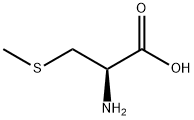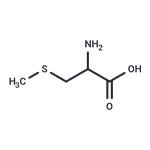
S-Methyl-L-cysteine
- Product NameS-Methyl-L-cysteine
- CAS1187-84-4
- CBNumberCB4154282
- MFC4H9NO2S
- MW135.18
- EINECS214-701-6
- MDL NumberMFCD00002612
- MOL File1187-84-4.mol
- MSDS FileSDS
Chemical Properties
| Melting point | ~240 °C (dec.) |
| Boiling point | 300.3±37.0 °C(Predicted) |
| alpha | -29.5 º (c=1,water) |
| Density | 1.149 (estimate) |
| refractive index | -30 ° (C=2, H2O) |
| storage temp. | Keep in dark place,Sealed in dry,Store in freezer, under -20°C |
| solubility | Aqueous Acid (Slightly, Sonicated), Aqueous Base (Sparingly, Sonicated) |
| pka | pK1:8.97 (25°C) |
| form | Solid |
| color | White to Off-White |
| BRN | 1721675 |
| LogP | 0.380 (est) |
| CAS DataBase Reference | 1187-84-4(CAS DataBase Reference) |
| EWG's Food Scores | 1 |
| FDA UNII | A34I1H07YM |
| NIST Chemistry Reference | s-Methyl-L-cysteine(1187-84-4) |
| UNSPSC Code | 12352209 |
| NACRES | NA.26 |
Safety
| Symbol(GHS) |

|
|||||||||
| Signal word | Warning | |||||||||
| Hazard statements | H315-H335-H319-H302 | |||||||||
| Precautionary statements | P264-P270-P301+P312-P330-P501-P264-P280-P302+P352-P321-P332+P313-P362-P264-P280-P305+P351+P338-P337+P313P | |||||||||
| Hazard Codes | Xn | |||||||||
| Risk Statements | 22 | |||||||||
| Safety Statements | 22-24/25-36/37/39-26 | |||||||||
| WGK Germany | 3 | |||||||||
| HS Code | 29309090 | |||||||||
| NFPA 704: |
|

